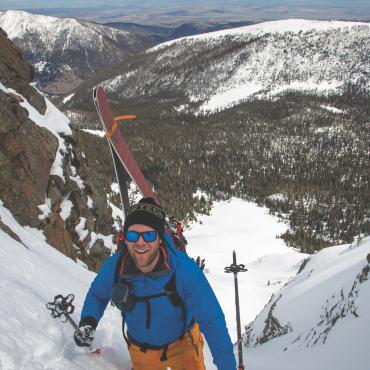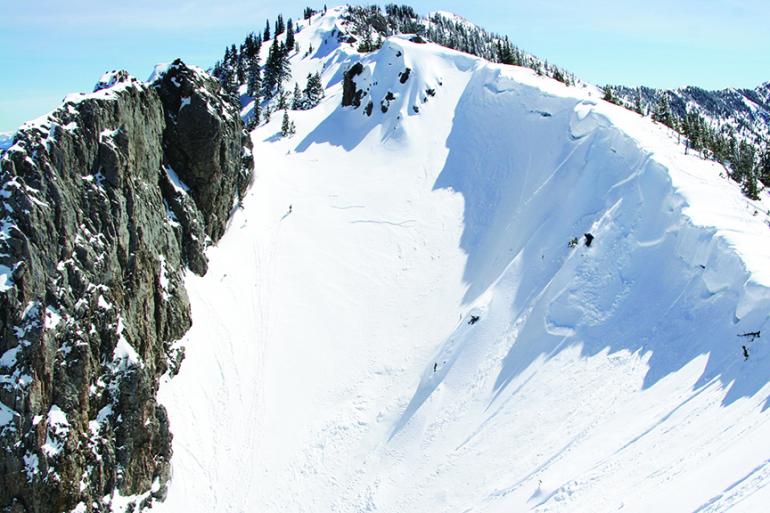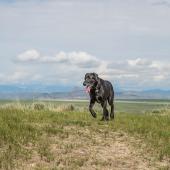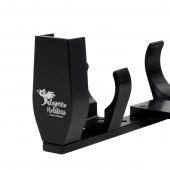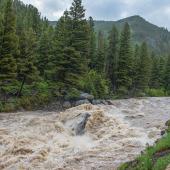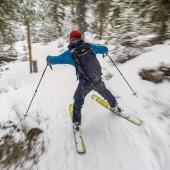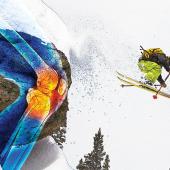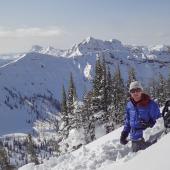Inflated Statistics
Avalanche airbags 101.
It’s windy; you hear it whistling across the ridge as you kick into your skis and stare down at 2,000 feet of untouched powder. You’ve hiked all day for this shot, and the reward is going to be sweet. One turn, two turns, three turns and the snow is perrrfect. But on your fourth turn, the entire slope fractures above you in a jigsaw puzzle of broken slabs, and suddenly you’re rag-dolling; you don’t know what’s up or down; your lungs are burning even as snow is packed down your throat; you’ve made a terrible mistake—you’re gong to die. Then, you remember your airbag backpack, pull the trigger, and suddenly find yourself floating calmly on top of the avalanche, able to breath, and virtually assured of a safe outcome. Whew, that was close one…
Unfortunately, avalanche airbags—backpack-mounted bladders that inflate in an instant to help avalanche victims stay near the top of the slide debris—don’t ensure a happy ending like the one described above. While airbags do have impressive potential to save lives by providing a greater chance of survival in an avalanche accident, airbag manufacturers are fond of hyperbole when representing their products’ efficacy. Recent research, however, shows more accurately how and when airbags are effective, and warns against “silver bullet” marketing with more accurate analysis of accidents in which airbags played a role. “Yes, they work;” says Doug Chabot of the Gallatin National Forest Avalanche Center (GNFAC). “Yes, they help people survive. But they don’t help as much as people are led to believe.”
Airbag backpacks aren’t new—the first was developed in 1985. But their use has skyrocketed in recent years within the two demographics of backcountry users most likely to die in avalanches: snowmobilers, and backcountry skiers and riders. Part of their popularity is due to aggressive advertising that represents their effectiveness as almost foolproof (e.g. “97% survival, “8x safer!”). A 2012 study by airbag manufacturer Backcountry Access found that these survival statistics are the number-one reason for airbag purchases among their customers. But while airbags are effective tools in certain last-ditch situations, the facts aren’t quite cut-and-dried. “The misconception is that it’s like a life jacket, and you’ll just float on top,” Chabot says. And that’s just not true.
In a 2014 story published by The Avalanche Review (TAR), a professional journal produced by the American Avalanche Association, leading airbag researcher Pascal Haegeli concludes that airbags increase your chances of surviving a serious avalanche involvement—defined as a slide with “potential for full burial,” size D2 or larger—by 11 percent.
Eleven percent might not seem like much—especially since many airbags cost more than $1,000. But, Chabot says, “If you’re buried in a hole, 11% seems like a lot. If you could buy something that gave you an 11% better chance of winning the lottery, you’d be excited.”
To draw his conclusions, Haegeli studied avalanche incidents in which users deployed airbags compared to a control group of similar incidents in which users did not have airbags, then did a statistical analysis to account for other factors: the characteristics of the incident, the avalanche itself, and the victims. He found that out of 100 victims without airbags, 22 are killed and 78 survive. Out of 100 people with inflated airbags, only 11 would have been killed. That’s a 50% improvement over not wearing an airbag—pretty darn good.
The distinction of “inflated” airbag is important. Haegeli found that out of all avalanche incidents involving an airbag, there was about a 20% non-inflation rate. Non-inflation was attributed to user error in 60% of these cases. “Mostly because people are failing to pull it,” Chabot explains. “For whatever reason they can’t get to it.” When factored into the analysis, non-inflations drop airbag users’ 50% mortality improvement to just 43%. Clearly, it’s critical that users are able to deploy their airbag properly.
Another potential problem identified by Haegeli is risk compensation: users taking more risk because they’re wearing an airbag. “Personal safety benefits from airbags are quickly nullified if individuals use them to justify increased exposure to terrain where larger avalanches are likely,” he writes. And, he concludes, “Risk compensation behavior is likely among airbag users, particularly among recreationists who are interested in pushing their physical and athletic limits.” Rippers be warned.
All variables aside, airbags do save lives, and Chabot is happy to see more backcountry users exploring their use. “It’s awesome,” he says, “and the reason it’s awesome is that people are taking avalanches seriously.” Last year 35 people died in avalanches in the U.S., and six of those occurred in Montana. At the very least, airbags save time in traditional avalanche rescue scenarios, since victims tend to end up near the surface of the debris, rather than deeply buried. “As soon as there’s something sticking out of the snow, there’s no beacon search,” Chabot explains. That saves precious time—and time is life.
The drawbacks of airbags today are threefold: price, weight, and ergonomics. Airbags generally run between $600-$1,200—a good chunk of change for anyone. The airbag and compressed gas canister also add several pounds to your backcountry kit, which may explain why snowmobilers have been quicker to adopt airbags: they don’t have to carry them uphill all day. Lastly, while they have improved immensely in recent years, airbag packs are simply more limited in number and design, so finding one to meet your specific needs and preferences can be difficult. As airbags become more ubiquitous, expect prices and weights to fall and custom options to increase.
Airbags do not guarantee survival. “They are an optional piece of equipment—a complement to other equipment,” Chabot says. “Your beacon, shovel, and probe are not.” And the most important tool in the avalanche game is still education. “You’ve gotta take a course—the number-one thing is to take an avalanche course,” Chabot reiterates. “If you’re new to the sport, start with an awareness class, but soon enough you’ll need a field component (Level 1).” The only absolute way to avoid being killed by an avalanche is to not be involved in one. If it comes down to a financial decision between buying an airbag and taking a course, Chabot suggests taking the course: “Education trumps a piece of gear any time, in any sport.”


